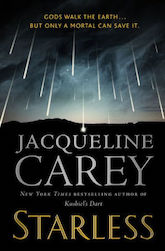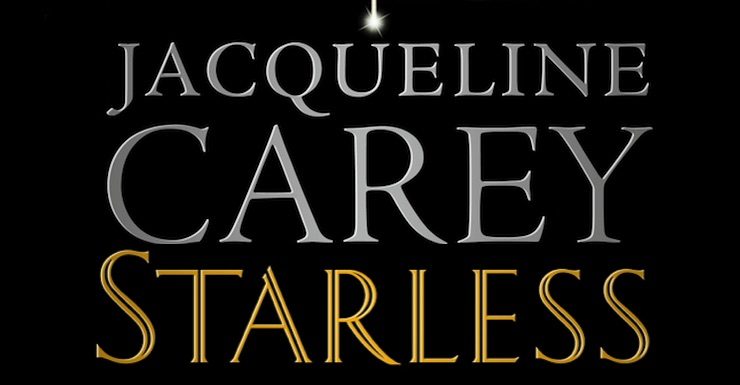The night sky in Jacqueline Carey’s latest novel Starless is—as the title of suggests—bare. But a thousand years ago, the sky was lit up with glittering stars. More than stars, they were gods: the children of all-seeing Zar the Sun and his three Moon wives: bright Nim, dark Shahal, and fickle wanderer Eshen. But the children, who remained in fixed points lending light at night and guiding sailors on the four great currents, envied their parents’ freedom to wander the day and night sky. And so, they rebelled.
Rather than discipline his children in the sky, Zar the Sun grew furious and punished his rebellious children by casting them down to earth. As the heavens emptied of their celestial beings, they struck different points on the land and in the sea. In each spot, that god or goddess took on the form of their surroundings, from fierce sandstorms to calming rains to enigmatic marble statues. And where each deity reigned, so their human scions built worship around their particular form and decrees.
It is a massive pantheon to keep track of, and each plays a key part in the novel’s Scattered Prophecy. From trickster gods to harmonious nature deities, here’s a handy guide to the major divine players in this epic standalone fantasy.
Zar the Sun
Not surprisingly, everything revolves around this sun god, “the father of us all.” Not only does Zar oversee his starry children that he bound to the earth, but his all-seeing eye also scans over the humans whose lives unfold beneath his bright gaze. He will ever light their paths during the day; and even when he dips beneath the horizon line and his moon-wives take his place in the starless sky, his influence is not forgotten.
Every member of the royal family (a.k.a. the Sun-Blessed, a.k.a. the House of the Ageless) has “zar” somewhere in their names, which make for some increasingly creative monikers: Azarkal, Kazaran, Tazaresh, Dozaren, and one of the protagonists of Starless, princess Zariya.
Nim the Bright Moon, Shahal the Dark Moon, and Eshen the Wandering Moon
The mothers of all creation sometimes share the night sky, and other times two will dip away and allow one to shine bright—or dark—on her own. It is the convergence of Nim the Bright Moon and Shahal the Dark Moon under which warrior Khai and princess Zariya are born. Depending on which moon reigns at a given time will set the tone for that night: there is the calming guidance of silver-white Nim, the bloody light of Shahal, and the fickle, shifting blue glow of Eshen. While Nim and Shahal bear various gods for Zar, it is Eshen’s hidden child who turns the tide of history.
Pahrkun the Scouring Wind
The Sacred Twins are among Zar’s most beloved children, which is why he cast them down to the east, so that when Zar rises at the start of the day he may see them first as he moves across the sky. While they protect Zarkhoum, they’re not exactly benevolent guardians; manifesting as sandstorms and veils of fire, they can be as unpredictable and dangerous as the weather.
Out in the deserts of Zarkhoum, Pahrkun watches over a Brotherhood of elite warriors, who have established their homes in the Fortress of the Winds. Trained from infancy, or at least adolescence, they mete out harsh judgment mirroring the desert itself: The Trial of Pahrkun is reserved for those men from far-off towns who have committed a crime meriting execution. They can choose instead to travel to the Fortress of the Winds and face three members of the Brotherhood in the Hall of Proving. Should the criminal make his way through, he will be scoured of his sins and welcomed into the Brotherhood.
Pahrkun’s scouring power can be seen in the shape of the Fortress itself (with its large stone basin crossed by a thin stone bridge) to how the Brotherhood worships him (leaving their dead to be reduced to bones) to the unique trial that every Brother must confront when he comes of age. This is especially harrowing for Khai, as it is his last step in childhood before going to the city of Merabaht to be united with his soul’s twin Zariya for the first time. It is one thing to live in a land shaped by the winds; it is wholly another to let oneself be shaped by Pahrkun.
Anamuht the Purging Fire
The Sacred Twins both stalk the deepest part of Zarkhoum’s desert—he whipping the sands into whorls, she crackling with lightning—but Anamuht also makes her way to Merabaht when it comes time to quicken the rhamanthus seeds in the Garden of Sowing Time. Each of these seeds glows with the immortal fire of Zar and grants another year of life to the person who ingests it. Veiled in sheets of fire, wielding lightning bolts and speaking in tongues of flame, Anamuht creates quite the spectacle when she quickens the rhamanthus seeds with her lightning (no other heat or flame can do the same). But she has not visited the Garden of Sowing Time in over a dozen years, sparking rumors of her displeasure with the house of the Sun-Blessed.
The priestesses of Anamuht are the keepers of lore including birth records—paying special attention to those births that occur during a lunar eclipse, as the twin births mirror the relationship between Anamuht and Parkhoun. They also deal in prophecies, like the one claiming that as the darkness rises in the west, a member of the Sun-Blessed will stand against it…
Droth the Great Thunder
The great dragon protects the land of Granth, which now teems with its offspring, great stink-lizards who spit deadly acidic bile. Like any good dragon, Droth mostly sticks to his lair, sleeping atop his pile of riches and dreaming of dominion over the humans. But once every seven years, he awakens in order to mark the ascension of a new Kagan—the Granthians’ leader, elected via combat—and bind his stink-lizards in service to their new leader.
Ilharis the Two-Faced
On the isle of Therin, whose inhabitants say one thing when they mean another, Ilharis is represented by a marble statue with two visages and two lines of sight—one east, one west. When fickle Eshen the Wandering Moon is full and casts her light down on Ilharis, the statue weeps crystal tears. Humans would be behooved, though not necessarily wise, to snatch those rare tears, as they have the ability to change one’s luck… but whether for the better or for the worse, will not be known until the fate-changer is used.
Lishan the Graceful
Barakhar’s deity sounds almost whimsical: a willow tree who can pick up her roots in order to wander and bestow her dew upon her people. But as one of Khai’s Brothers points out, “Grace and guile can be deadlier than any stink-lizard’s bile, and luck can change any outcome.”
Obid the Stern
Many countries with their own gods regardless turn to Itarran and its deity as keepers of justice. The coursers of Obid sail all around rooting out pirates and smugglers, while the realm’s elected official (replaced every decade) follows the god’s example of solemn, fair judgment unencumbered by either vice nor emotion.
Dulumu the Deep
The god of the sea who gave the Elehuddin (themselves having adapted to the sea with their webbed feet and tendril-like hair) command of the sea-wyrms, a.k.a. the fan favorite characters of Starless.
Quellin-Who-Is-Everywhere
Trickster god who shifts into different guises as suits him; despite everyone knowing his M.O., he is rarely actually recognized. Quellin’s propensity for shapeshifting inspired the people of Drogalia to tattoo themselves—the one aspect he cannot duplicate—so as to assert their true identities and histories. Though he often makes fools of his scions for his own delight or even pleasure, he also rewards them with divine gifts, such as the ability to pass through any space, much like he can.
Luhdo the Loud
The god of thunder, who delivers the stunning power of a thunderclap unto his scions from Trask.
Ishfahel the Gentle Rain
Does the Verdant Isle gain its name from Ishfahel, or did Ishfahel come to embody the gentle rain because the isle needed to remain green? It is unclear, but the two exist in a harmonious cycle, with the misty, larger-than-life Ishfahel embodying the coolness and peace of a cleansing rain and bestowing her restorative water upon locals and travelers alike.
Selerian the Light-Footed
Despite being the daughter of fickle Eshen, Selerian in turn inspires in her scions, of the Chalcedony Isle, a powerful but short-lived love. For they are mayflies, able to move light-footedly and swiftly through their brief lives.
Shambloth the Inchoate Terror
No one really knows what Shambloth looks like, only that he instills “mind-rending fear” in anyone unlucky enough to trespass on the island of Papa-ka-hondras. There are a thousand ways that the island could kill those who are unwelcome, from the very concrete dangers like death-bladders to the nameless, permeating fear that lurks just beyond the edge of the campsite. Not being able to contain Shambloth to one shape just makes him that much scarier. (In our recent interview, Carey describes the Inchoate Terror as “a little Lovecraftian action there without any of the—hopefully—misogyny and racism.”)
Galdano the Shrewd
For the Tukkani, trade is a form of worship, which means it must be performed with the correct intent. As Galdano—the rare fixed god, who does not move from his place of worship—decreed long ago, the worth of a thing can only be determined through trade. As petitioners come with their worldly goods to offer up to Galdano, the god’s many constantly moving hands weigh, note, and trade the items for treasure or scraps of paper whose value only Galdano may understand.
Johina the Mirthful
Buy the Book


Starless
Every pantheon needs a god, or goddess, who embodies pure joy: always dancing, adorned with flowers and birds caught in her celebratory movements, always on the verge of laughter.
Miasmus
Poor Miasmus, forbidden child hidden away by a fickle mother and raised not as a star, but in complete darkness. Poor Maw, yearning for love but instead filled with distrust and hatred. If you were punished for a rebellion that your thousands of siblings committed, that you had neither hand in nor even knowledge of, you too would be an Abyss That Abides. We won’t say more, as much of the plot hinges on this misunderstood deity, but Miasmus’ role in the story is as distant from omnipotent, omniscient Zar as can be—making the gods’ family drama, and its long-reaching ramifications for the earthly scions, all the more human.
Starless is available now from Tor Books. Read an excerpt!
Natalie Zutter would read a whole side novella about Ilharis the Two-Faced or Quellin-Who-Is-Everywhere. Talk epic fantasy with her on Twitter!










